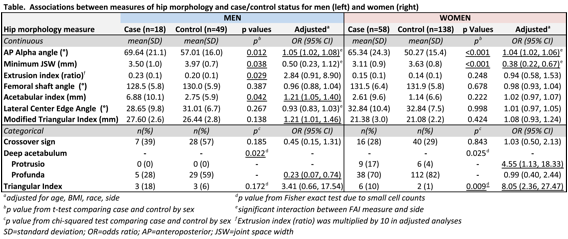Session Information
Session Type: Abstract Submissions (ACR)
Background/Purpose: Alterations in hip morphology, such as femoroacetabular impingement, have been associated with incident hip OA and total hip replacement (THR), but have rarely been assessed in community-based samples and have never been assessed in African Americans (AA).
Methods: This case-control study was nested within a large community-based cohort. Case hips had Kellgren Lawrence grade (KLG)<3 on baseline supine pelvis radiographs and KLG³3 (mild/moderate hip OA, or THR for OA) at the 1st or 2nd follow-up (mean 6 and 12.7 years, respectively) visit. Control hips had KLG<3 at both baseline and follow-up, with a gender/race distribution similar to cases. Validated software (Oxmorf) was used to assess 27 aspects of hip morphology. Unadjusted analyses comparing cases and controls included chi-squared and t-tests, as appropriate. Generalized estimating equations regression models, adjusted for age, race, BMI, and side were employed, accounting for within-person correlation.
Results: A total of 263 hips, 76 case and 187 control, were included from 136 individuals (25% male, 29% AA, mean age 62 ± 9 years and BMI 30 ± 6 kg/m2). Case hips were more often right hips (67%, p<0.001), with no differences by age or BMI. Reliability for all measures was acceptable (intra- [ICC 0.7-1.00] and inter-reader ICC 0.5-1.00). Nearly all measures were significantly different by sex (p<0.03 in t-tests) so further analyses were sex-stratified; no interactions were seen for age, race, BMI, or baseline KLG.
For analyses by case/control status, we focused on 7 continuous and 3 categorical hip morphology measures (Table). Among men, higher baseline AP alpha angle, extrusion index, acetabular index, and modified triangular index height were associated with case status at follow-up, while greater baseline minimum joint space width (mJSW) and coxa profunda had a protective effect. Among women, higher AP alpha angle, lower mJSW, presence of protrusio acetabuli and the triangular index sign were significantly associated with case vs. control status. Strength of some associations varied by side (data not shown). With all measures simultaneously included in the model, the associations between AP alpha angle and mJSW remained significant for both men and women, as did the triangular index sign among men only.
Conclusion: Cam-type morphology (higher AP alpha angle and triangular index) and smaller mJSW were associated with incident radiographic hip OA in both men and women, with no differences by race. Newly identified variations in these associations by side are of interest and will be the subject of future work.
Disclosure:
A. E. Nelson,
None;
J. L. Stiller,
None;
X. A. Shi,
None;
K. M. Leyland,
None;
J. B. Renner,
None;
T. A. Schwartz,
None;
N. K. Arden,
None;
J. M. Jordan,
None.
« Back to 2014 ACR/ARHP Annual Meeting
ACR Meeting Abstracts - https://acrabstracts.org/abstract/measures-of-hip-morphology-are-related-to-development-of-incident-radiographic-hip-osteoarthritis-over-6-to-13-year-follow-up-the-johnston-county-osteoarthritis-project/

